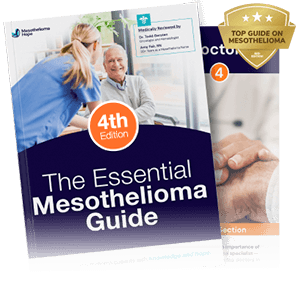What Is the Survival Rate of Mesothelioma?
Data from the National Cancer Institute (NCI) shows about 12% of patients diagnosed with mesothelioma are still living 5 years later. However, many patients have survived much longer with surgery and other treatments.
Survival rates are often shared as part of your prognosis (your projected health outlook) and can vary based on your specific type of mesothelioma, the stage of the cancer, the cell type, and any treatments you receive.
While these numbers tell part of the story, they don’t define your journey. Every patient’s experience is unique, and there’s always hope for progress, personalized care, and a brighter future.
Mesothelioma Survival Statistics
The chart below shows average mesothelioma survival rates at 1, 3, and 5 years.
| Time After Mesothelioma Diagnosis | Survival Rate |
|---|---|
| 1 year | 43.7% |
| 3 years | 16.8% |
| 5 years | 12% |
These percentages are based on large numbers of past patients. Many factors can influence your prognosis, especially the type of treatment you receive and how your cancer responds.
Is Mesothelioma Survival Rate the Same as Life Expectancy?
No. Mesothelioma life expectancy is the estimated time a patient is projected to live. It’s typically measured in years or months. The average life expectancy for mesothelioma is 12-21 months.
Mesothelioma survival rates provide a high-level snapshot of how many people survive for a certain period after diagnosis, but they can’t predict exactly what will happen in your case.
Get our Free Mesothelioma Guide shipped overnight to learn more about mesothelioma survival rates and life expectancy.
Survival Rates for Each Type of Mesothelioma
Mesothelioma survival rates can differ significantly based on where the cancer develops in the body.
Pleural Mesothelioma Survival Rate
Pleural mesothelioma develops in the lining of the lungs (pleura) and is the most common type of mesothelioma.
The chart below shows overall pleural mesothelioma survival rates.
| Time After Diagnosis | Survival Rate |
|---|---|
| 1 year | 73% |
| 3 years | 23% |
| 5 years | 12% |
| 10 years | 5% |
These survival rates are significantly higher when patients undergo pleural mesothelioma surgery.
There are two major types of pleural mesothelioma surgery:
- Extrapleural pneumonectomy (EPP): Doctors remove the affected lung and all visible tumors from the heart lining, lymph nodes, and diaphragm. In a clinical trial, patients who received an EPP, chemotherapy, and radiation had a 5-year survival rate of 24%.
- Pleurectomy with decortication (P/D): Doctors remove the lung lining and all visible cancer but spare both lungs. The 5-year mesothelioma survival rate is 29% with P/D, according to a report in the Journal of Thoracic Disease.
These surgeries, especially combined with other treatments, offer hope for significantly extending survival in patients battling pleural mesothelioma.
Peritoneal Mesothelioma Survival Rate
Peritoneal mesothelioma develops in the lining of the abdomen (peritoneum). Because it typically doesn’t affect vital organs like the lungs or heart, it’s easier to target with surgery than pleural mesothelioma and has higher survival rates.
Peritoneal mesothelioma cancer survival rates are provided in the chart below.
| Time After Diagnosis | Survival Rate |
|---|---|
| 1 year | 92% |
| 3 years | 74% |
| 5 years | 65% |
| 10 years | 39% |
Patients who get mesothelioma surgery often have higher survival rates. Over two-thirds of patients (69%) are still alive 5 years after cytoreductive surgery with HIPEC (heated chemotherapy), according to the University of Maryland Marlene and Stewart Greenebaum Comprehensive Cancer Center.

“Overall survival for this disease is typically in the 5-year range overall. Patients who present early do a lot better than somebody coming to the emergency room with a belly full of fluid with disease.”
Survival Rates for Rare Mesothelioma Types
Pericardial and testicular mesothelioma are two very rare types of this cancer. Pericardial mesothelioma develops in the heart lining (pericardium), and testicular mesothelioma starts in the lining of the testicles.
The mesothelioma survival rates for each type are shown in the table below.
| Time After Diagnosis | Pericardial Mesothelioma Survival Rate | Testicular Mesothelioma Survival Rate |
|---|---|---|
| 1 year | 26% | Not reported |
| 3 years | 14% | Not reported |
| 5 years | 9% | 49% |
| 10 years | Not reported | 33% |
The best way to extend your survival is to get treatment from a mesothelioma specialist. Use our Free Doctor Match to connect with top surgeons and oncologists near you.
Mesothelioma Survival Rates by Cancer Stage
Mesothelioma staging is one of the most useful ways to break down patient survival rates. The stage of mesothelioma refers to how far the cancer has spread at the time of diagnosis.
Pleural mesothelioma is the only type of this cancer that uses an official staging guideline. It is known as the tumor-node-metastasis (TNM) staging system and is the global standard for classifying cancer spread.
The chart below shows life expectancy and survival rates for all four stages in patients treated with surgery.
| Mesothelioma Stage | Life Expectancy | 2-Year Survival Rate | 5-Year Survival Rate |
|---|---|---|---|
| Stage 1 | 19.2 months | 39% | 11% |
| Stage 2 | 19.2 months | 39% | 11% |
| Stage 3 | 18.9 months | 41% | 13% |
| Stage 4 | 13.1 months | 31% | 11% |
*Note: NCDB data indicates no difference in life expectancy or survival rates between Stage 1 and Stage 2.
Many survivors have defied these statistics and lived much longer than their mesothelioma doctors predicted. Take John Stahl, for example, a retired construction worker who was diagnosed with stage 4 mesothelioma in 2019 and is still thriving more than 5 years later.
Mesothelioma survivor John Stahl was diagnosed with stage 4 pleural mesothelioma in 2019. More than 5 years later, he's still enjoying his golden years with his wife, Dee. Call us today at (866) 608-8933 to get the medical help you need to become a survivor. View Transcript.
Duration: 2 min 59 sec
Dee Stahl:
The day started out fine. We got up and John, which is unusual for him, just came out of the bedroom and just sat down, and he said, “I just don’t feel good.” And I knew something was wrong because John doesn’t complain. And I said, “Well, I think we should probably go to the ER.” They found out that there was over two liters of fluid on his left lung, and they were amazed that he was even able to breathe, period. They did a CAT scan, and that’s when he just said, “You have stage four mesothelioma, John.”
John Stahl:
I was kind of blank. I didn’t know what to think. I didn’t realize that my job had exposed me to this.
Dee Stahl:
We’re the Stahls. I’m Dee, and this is my husband, John.
John Stahl:
My name is John Stahl. I was first exposed to asbestos poisoning through the construction business, through Sheetrock®, through gaskets, and piping all through my career. And I worked 43 years in the construction business. If you don’t work, you don’t get paid. The first treatment was with chemotherapy, and I went every two weeks. It didn’t take long, an hour or so, but it would take me seven to 10 days to recover. That was hard for me because I’m a pretty active person. At first, it didn’t really sink in. The longer I thought about it, it’s gonna end my life eventually, but I’m gonna live it…as well as I can.
Dee Stahl:
Being with John through this, I’m glad I was here for him. He’s got a lot of support. He’s got a lot of friends and family that really care for him. But to be there, John made it easy because he was so positive. I’m just glad I was here for him. He held me up, really.
John Stahl:
Having Dee with me going through this was indescribable. It’s important for people to understand that there’s help and there’s people that are willing to help them.
Dee Stahl:
I think John’s positive attitude has kept him going like he has, having John so halfway healthy. I mean, he’s able to do things and be happy. John’s a very positive guy. He makes you happy.
Survival Rate by Mesothelioma Cell Type
Mesothelioma tumors are made up of different types of cells, and each type can greatly impact patient survival. The three mesothelioma cell types are epithelioid, sarcomatoid, and biphasic (a mixture of epithelioid and sarcomatoid cells).
The epithelial mesothelioma survival rate is the highest since these cells spread more slowly and respond well to treatment. Sarcomatoid mesothelioma cells tend to spread rapidly through the body and are more resistant to treatment.
Mesothelioma survival rates with surgery for all three cell types are shown below.
| Cell Type | 2-Year Survival Rate | 5-Year Survival Rate |
|---|---|---|
| Epithelioid | 45% | 14% |
| Sarcomatoid | 15% | 4% |
| Biphasic | 22% | 5% |
Call (866) 608-8933 now to get help accessing life-extending treatments. Our registered nurses and Patient Advocates can connect you with the very best mesothelioma doctors for your diagnosis, stage, and cell type.
Other Factors Affecting Mesothelioma Survival Rates
Historically, mesothelioma has mostly affected men over the age of 65. However, anyone can develop mesothelioma, and better testing and awareness are leading to earlier diagnoses. In addition to age, certain demographic factors may help or hinder long-term survival.
The charts below show how gender, age, and race affect survival rates for mesothelioma.
Gender
Though most mesothelioma patients are men, women with mesothelioma tend to live longer.
| Time After Diagnosis | Male | Female |
|---|---|---|
| 1 year | 41.3% | 51% |
| 3 years | 13.6% | 26.5% |
| 5 years | 8% | 18.8% |
Research suggests that hormonal differences, particularly the presence of estrogen, might play a role in better survival outcomes for women. One study published in the American Journal of Clinical Oncology found that increased estrogen may improve survival and provide a potential target for future therapies.
Regardless of a patient’s sex, an early diagnosis and personalized treatment are critical in improving survival rates.
Age
National cancer data shows that patients older than 50 have a lower mesothelioma survival rate.
| Age Group | Overall 5-Year Survival Rate |
|---|---|
| Under 50 | 44.7% |
| 50-64 | 21.2% |
| 65 and up | 8.3% |
| All ages | 13.5% |
Younger patients are typically in better overall health and are more likely to respond to surgery and other life-extending treatments.
Genetics
People with mutations in the BAP1 gene (BRCA1-associated protein-1) are at a higher risk of developing mesothelioma. These genetic mutations can cause the disease to develop differently, which may affect overall survival.


“I think eventually there will be some sort of genetic testing of the tumors, molecular genetics, that will say these are more favorable for aggressive treatments or this type of chemotherapy or this type of immunotherapy.”
As research advances, new therapies could emerge that target specific genetic mutations that are resistant to standard treatment, potentially improving mesothelioma survival rates.
Improving Mesothelioma Survival
Multimodal therapy combines two or more treatment methods and is the most effective strategy to improve mesothelioma survival times.
Mesothelioma treatment options include:
- Surgery to remove as much of the cancer as possible, preventing further spread and improving quality of life
- Chemotherapy with cancer-killing drugs administered before and/or during tumor-removing surgery
- Immunotherapy to help the body’s immune system identify and attack mesothelioma cells
- Radiation therapy with high-energy waves to damage the DNA of cancer cells and shrink tumors
- Clinical trials testing new or experimental medications and treatment combinations to increase survival rates
Mesothelioma Hope can help you access treatment at top cancer centers in your area. Use our Free Doctor Match service to get started.
Mesothelioma Survival Rates Without Treatment
The mesothelioma survival rate for patients who do not undergo treatment is low because this cancer will continue to spread if left untreated.
For example, a study published in Cancer Medicine found that pleural mesothelioma patients who didn’t get surgery had a 5-year survival rate of 5%. The survival rate more than tripled to 16% for patients who did get surgery.
Remember: Seeking treatment is the best way to extend your life expectancy. Contact our team for help accessing top mesothelioma treatments at the best cancer centers in the country.
Stories of Mesothelioma Survivors
Countless mesothelioma patients who were originally given little hope have defied the odds, living years beyond their initial prognosis.
Discover the inspiring stories of mesothelioma survivors who outlived expectations and proved that long-term survival is possible.


Arthur's Story
- Diagnosis: Pleural mesothelioma
- Year of Diagnosis: 2018
- Treatment: Chemotherapy, immunotherapy, and complementary and alternative medicine (CAM)
Arthur “Art” Putt first complained of shortness of breath in early 2018. Following a series of tests, doctors confirmed he had pleural mesothelioma.
Originally given only 6 months to live, Art proved his doctors wrong by undergoing treatment and incorporating a nutrient-rich mesothelioma diet.
“Get as close to your family and friends as you can. Stay positive and keep a positive attitude.”


Julie's Story
- Diagnosis: Peritoneal mesothelioma
- Year of Diagnosis: 2006
- Treatment: Chemotherapy and cytoreduction with HIPEC
Julie Gundlach received a shocking peritoneal mesothelioma diagnosis right after losing her father to asbestos lung cancer. He was an electrician who worked with asbestos products and unknowingly brought tiny asbestos fibers home on his clothing, which is how Julie was exposed.
Julie was only in her 30s when she was diagnosed and given 6-12 months to live. But, after undergoing a wide range of treatments, her cancer is now stable. This means it’s no longer growing or spreading.
“Keep the faith and keep putting one foot in front of the other.”
Get Help Surviving Mesothelioma
Mesothelioma survival rates can provide some insight into your prognosis, but they only tell part of the story.
Even with a challenging prognosis, many patients live far longer than expected. At Mesothelioma Hope, we’re here to support you every step of the way.
You can count on us to provide:
- Personalized doctor recommendations
- Dedicated support from our nurses
- Assistance with financial compensation
Call us today at (866) 608-8933 or use our Free Doctor Match to get started.
Mesothelioma Survival Rate FAQs
How long can you live with mesothelioma?
The average life expectancy for mesothelioma is 12-21 months.
However, every mesothelioma case is unique, and some patients have survived over 15 years, defying the odds and embracing life.
With advances in treatment and a strong support system, there’s hope for a better outcome and more time with your loved ones.
Is mesothelioma 100% fatal?
Mesothelioma is a serious condition, but it’s not an automatic death sentence.
While this diagnosis is challenging, many patients are living longer and healthier lives thanks to early detection and advancements in treatment.
Can you survive peritoneal mesothelioma?
Yes, you can survive peritoneal mesothelioma, especially with an early diagnosis and the right treatment. Peritoneal mesothelioma, which affects the abdominal lining, has a better outlook than other types of mesothelioma, particularly when treated with surgery.
Here’s the good news:
- The median survival time for patients who get cytoreductive surgery with HIPEC can range from 3-5 years, and many live much longer.
- Overall 5-year survival rates for patients treated with surgery can be as high as 50%, with some even surpassing the 10-year mark.
While peritoneal mesothelioma is serious, these numbers show that long-term survival is always possible.
What is the stage 1 mesothelioma survival rate?
Mesothelioma has a 1-year survival rate of about 44%, which means nearly half of those diagnosed are still alive a year later.
However, this one statistic doesn’t define your journey. With the guidance of a skilled mesothelioma specialist and the right treatments, you have the potential to live much longer and enjoy a better quality of life.
Has anyone ever survived mesothelioma?
Yes, many mesothelioma patients have achieved long-term survival, with some living 15 years or more.
These survivors took control of their future by advocating for themselves and actively participating in their treatment. They are proving that it’s possible to reclaim your life and thrive beyond a mesothelioma diagnosis.
If you’re facing mesothelioma, contact us today to learn how we can connect you with local mesothelioma specialists.
Can mesothelioma be cured if caught early?
Mesothelioma isn’t officially curable, but if it’s caught early, you have a much better chance of going into remission or potentially being declared cancer-free.
In the early stages, the cancer is typically confined to one area, making it easier to target with surgery, chemotherapy, and radiation. This can significantly improve survival and offer hope for a longer, healthier life.







